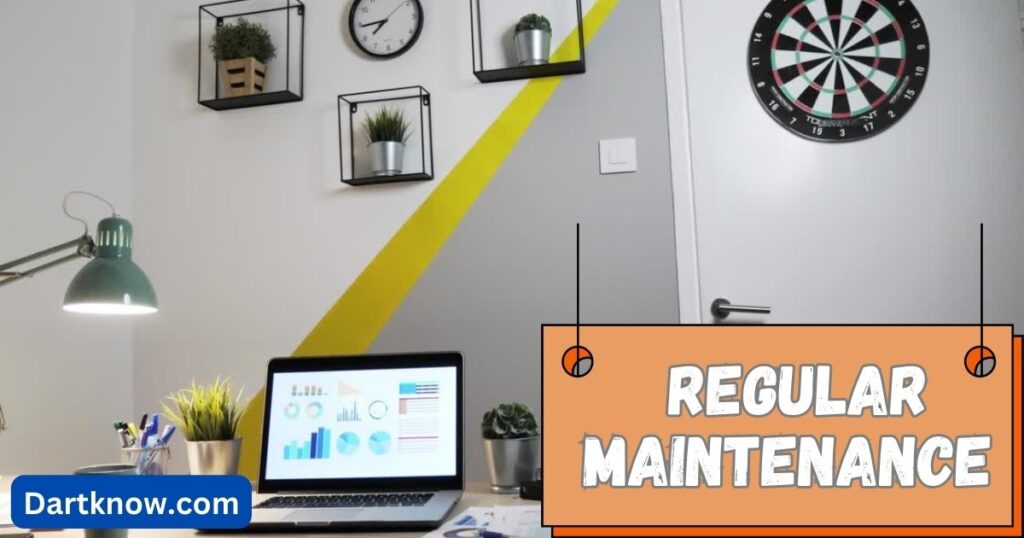How to Care for Your Dartboard

Proper care is essential to ensure your dartboard lasts a long time and works at its best. Consistent dartboard care improves the playing experience by extending the board’s lifespan and ensuring accurate and reliable scoring. Neglecting care for your dartboard can lead to a covered board and eventually necessitate expensive replacements, diminishing the quality of your games.
Dartboards are typically constructed from various materials, each offering distinct advantages. Common types include plastic, often found in electronic dartboards; cork providing flexibility and a softer surface; and sisal, renowned for its durability and self-healing properties. Understanding these components is crucial for selecting the appropriate dartboard and providing the necessary dartboard care.
Choosing the Right Location
Ideal mounting height and distance
For a fun game, it’s important to take into account the correct mounting height and distance when creating your dartboard. The dartboard’s center should normally be 5 feet 8 inches (1.73 meters) over the ground.
The dartboard is set up at a distance of 7 feet 9.25 inches (2.37 meters) from the front. Applying these guidelines promotes regularity and maximizes performance for players of all ability ranges.
Avoiding direct sunlight and moisture
It is best to install dartboards away from bright sunshine and moisture. Excessive periods of sunlight can cause the board to age and the components to decrease, while moisture can cause bending and other problems. To maintain the integrity and quality of the board over time, consider locations that are inside or offer lots of shade.
Ensuring safety and accessibility for players
The primary issue to consider when placing your dartboard is safety. Make sure there is enough space surrounding the board to prevent errors and let players toss darts without thinking about striking other players or surrounding items. Accessibility is also crucial. The setup should allow users of different sizes and abilities, guaranteeing an enjoyable and friendly atmosphere for all.
Regular Maintenance

Cleaning the Dartboard
To improve its lifespan and guarantee top performance, a dartboard needs to be properly cleaned. For bristle boards, remove the tips of the darts carefully and clean the surface with a soft brush or cloth. Any strong chemicals should be used since they may harm the fibers.
You can use a moist towel to clean the surface of electronic boards, but be sure the moisture is not trapped inside the electrical parts. Preserving the board’s surface and ensuring that darts pass through smoothly and without restriction are two benefits of regular cleaning.
Rotating the Board
Rotating your dartboard effectively prevents it from breaking evenly and maintains its functionality. By moving the board periodically or after a significant amount of play, you can equally spread the effect of the dart throws over the surface.
This practice helps maintain the quality of the board and enhances the overall playing experience. A recommended rotation schedule is to adjust the board every 200 throws or at least once a month, depending on usage.
How to Care for Your Dartboard: Protecting the Dartboard
Using a protective covering when not in use
When your dartboard is not in use, it is important to secure it to protect it from particles, dust, and potential harm. It may include simple fabric or a special dartboard covering that protects its surface from the weather and improves its longevity. Covering the board also helps maintain its appearance and prevents unwanted wear during periods of inactivity.
Avoiding excessive force when throwing darts
Throwing darts requires consistency and command, which is important for both the longevity of your dartboard and your success in the game. When not applying too much force, you may reduce the impact on the board’s surface, reducing the possibility of harm and extending its lifespan.
To create a safe and reliable throwing experience, players should be instructed to choose techniques that are above strength.
Keeping darts in a safe place to prevent damage
Proper storage is essential to prevent damage to the tips and the dartboard itself. Always keep darts in a dedicated case or holder when not in use. This prevents bent tips and lost flights, which can affect gameplay and the board’s condition.
Proper storage also helps avoid accidental drops that could lead to dents or other damage on the dartboard, ensuring both the darts and the board remain in excellent shape for future games.
Repairing Your Dartboard

Identifying signs of wear and tear
It’s critical to identify wear and tear symptoms on your dartboard if you are interested in maintaining its efficiency and lifespan. Accessible holes where darts have poked ripped or broken fibers in bristle boards and a detectable change in the surface of the board are typical symptoms.
For electronic boards, look out for malfunctioning segments, unresponsive buttons, or impaired scoring displays. You can detect these problems early with the help of regular tests, providing quick repairs or fixes.
How to fix holes and dents on bristle boards
Repairing holes and dents in bristle boards will greatly increase your dartboard’s lifespan. Use a basic dartboard repair kit that can be obtained from stores for small holes. These kits usually come with fibrous plugs that may be placed in the destroyed region.
If the damage is more serious, you may need to rotate the dartboard to a less-used place or add more sisal fibers to fix it. Always ensure the surface remains even and accessible for accurate throws.
Considerations for replacing electronic dartboard components
If difficulties occur with electronic dartboards, a component change can be essential. Check the manufacturer’s guarantee and assistance options before buying new parts; others provide services to replace damaged parts. You must pinpoint the specific parts that require replacement, such as the sensors, wiring, or scoring display.
To keep the board’s stability and performance, make sure you carefully follow the manufacturer’s recommendations while modifying parts.
FAQs
How often should I clean my dartboard?
Cleaning your dartboard is suggested regularly, ideally, a few plays in or once a month. Keeping it clean helps maintain its appearance and performance.
What should I do if my dartboard starts to show significant wear?
If you notice significant wear, consider rotating the board to a less-used area or using a dartboard repair kit for minor holes. Larger losses may indicate that it’s time to consider obtaining a replacement.
Is it necessary to cover my dartboard when not in use?
Yes, you can add a layer of protection that protects your dartboard from dust, debris, and other outside effects. This will allow it to maintain its attractive appearance and improve its longevity.
How can I ensure safety while playing darts?
Make sure there is sufficient space behind the dartboard to prevent errors and motivate individuals to shoot darts carefully so they don’t hit other people or nearby items.
Conclusion
In conclusion, regular servicing and care are crucial for preserving the longevity and usability of your dartboard. The lifespan of the board can be significantly extended by regular cleaning, board rotation, and the use of protective covering. Additionally, careful handling while throwing darts and proper storage of darts prevent unnecessary damage. By identifying early signals of wear and tear, you may quickly perform repairs to keep your dartboard in excellent condition and keep enjoying the game.
We recommend that all players follow these guidelines to maintain the quality of their dartboard. Proper treatment of the equipment and adhering to the maintenance schedule may optimize the return on investment and improve your gaming experience. Regular maintenance will extend the lifespan of the dartboard and improve accessibility, allowing you to enjoy every game to the maximum.




